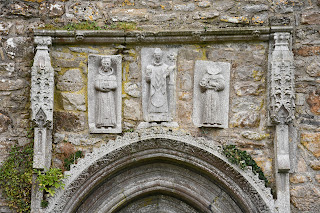Ireland: Day 3 – Brú na Bóinne, Tara, and Clonmacnoise
A visit to Brú na Bóinne takes some planning: the website advises visitors to book tickets in advance, and with good reason. When I arrived at nine in the morning, there were signs by the visitor centre saying that tickets for the day had already sold out. Luckily, I had bought mine a whole month in advance.
After being let in at
nine o’clock, my group was given forty-five minutes to walk around the museum
and slowly make its way to the bus stop. The exhibits did a good job of
illustrating the importance of Brú na Bóinne: with its major structures dating
back more than 5,000 years, the site predates the Egyptian pyramids – both
being ancient burial sites. It is also older than Stonehenge, and just like
Stonehenge, it was built by Anatolian migrants, with later additions to the
site being made by distinct waves of immigrant populations. The purposeful
alignment of the structures with solar events shows a complex understanding of
astronomy; in fact, one engraving on a stone at Knowth even maps out the lunar
and solar calendars and the time it takes for both cycles to converge.
The bus first took us
to Knowth, where our tour took us around the outside of the main tomb. This
tomb is surrounded by a number of smaller knolls, and there is a reconstructed
“woodhenge” on the far side from the entrance. In the Middle Ages, a
fortification was constructed on top of the tomb, which was eventually converted
into a less heavily fortified structure as rulers pacified the surrounding
areas. When this happened, a walkway was constructed to the top of the
monument, which stands to this day and allows tourists to observe the
surrounding landscape.
From Knowth, the bus
continued to Newgrange, which is by far the best-known site at Brú na Bóinne.
There, our 24-member crowd was split in two, as the inside of the monument was
too small to house all of us at once. The inside of Newgrange, which dates to
3,200 BCE, was remarkable. We paused in wonder as we looked at the corbelled
vault roof towering high above our heads, knowing that without mortar it
supported many more tonnes of stones and earth. The slabs, we were told, sloped
downwards on the outside so as to prevent leakage, which was further aided by
some kind of prehistoric caulk.
The austerity of the
chamber amplified the remarkable craftsmanship that has kept this monument
standing for five thousand years. The niche on which the sunbeam falls every winter
solstice was almost completely bare, except for a mysterious, inward-facing
triple spiral. On the right side of the chamber was a beautifully smooth basin
stone, the purpose of which appears ritualistic but remains unknown. There were
few engravings beside graffiti and a diamond shaped pattern that can also be
seen on some of the stones outside.
The tour of Brú na
Bóinne ended at midday. I quickly continued to the nearby Hill of Tara, as the
food at the visitor centre was absurdly priced and I was getting hungry. I
found a bistro right under the hill, where I bought a few more acceptably
priced items and ate them on my walk up. After visiting Brú na Bóinne, I found the
site somewhat less impressive, though it is no less historically important. It
houses a passage tomb smaller than Newgrange and Knowth but similarly ancient;
it is estimated that as many as 500 people may have been interred there.
The Hill of Tara is
mainly known as the inauguration place of the High Kings of Ireland and
features prominently in early Irish literature. Tradition identifies the
standing stone – which remains at Tara to this day – with the legendary Lia Fáil, the stone of destiny that cries out under the foot of the rightful
king. The site also witnessed the great legendary battle between King Cairbre
Lifechair and Fionn Mac Cumhaill’s Fianna, who were soundly defeated and buried
across the area.
My departure from Tara
spelled the start of an exhausting traversal of Ireland from east to west.
Beginning just a few miles away from the Irish Sea in the morning, I was to
reach Kinvarra on the Atlantic coast by dusk. On the way, the only place I
visited was Clonmacnoise, a sixth century monastery founded by Saint Ciarán. A place of considerable historical significance, the monastery is where
many high kings of Tara were buried, and it was pillaged numerous times by the
Irish, the Vikings, the Normans, and even the English. Its most notable
attractions are its two round towers and three ornate high crosses. The
originals are housed in an on-site museum, while the ones strewn throughout the
monastery are faithful replicas.
Having some time to
spare by the time I arrived in Kinvarra, I decided to take a look around the
neighbourhood of the castle. I found a few cars parked by the side of the road
rather than the official parking lot, so I left the car there while I walked up
and down the coast, reaching as far as the quaint old centre of Kinvarra. With
much of the coast walled off by private landowners, I would say that the best
views of the castle are probably from the side of the road (despite facing
Dunguaire, Kinvarra is a little too far away to offer very good views of it).



















































Comments
Post a Comment